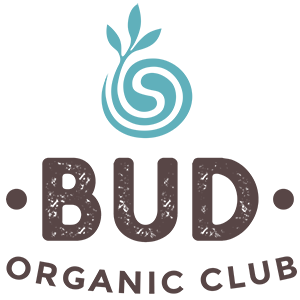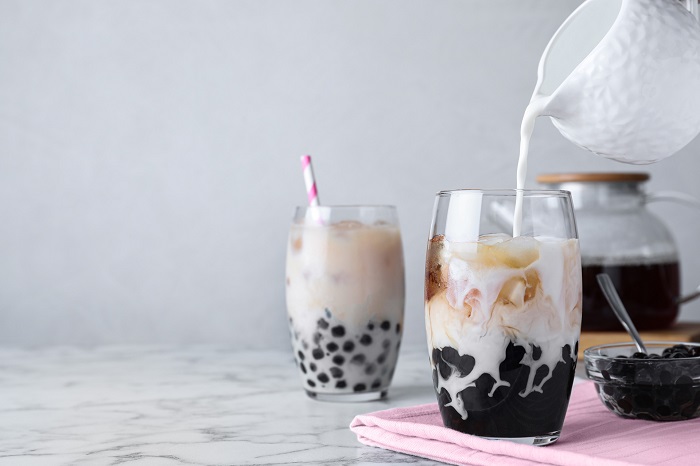Recipe by Dr Sarah Lantz
Bubble tea, I know, right? So fun! Otherwise known as Boba tea, pearl tea, tapioca milk tea, or just simply Boba or zhenzhu naicha, depending on where you come from. Bubble tea is all the rage right now and looks like it’s here to stay with outlets sprouting up across the country. Who knew that putting chewy things in tea would become such an obsession?! Maybe it’s the texture of the round tapioca balls, the satisfaction of popping the pearls, or the slippery, crunchy jellied seeds and remnants at the bottom of the cup. People are definitely becoming strangely more accustomed to having chewy bits in their drinks. Just go to most shopping centres and you will see groups of young people strolling around sipping (and chewing) large colourful beverages through oversized straws with friends.
While it is thought that the Boba culture started in the late ’80s, its origins are debated, but most refer to Boba tea as originating in Taiwan. In Taiwan, Boba is a staple of the night markets where stall owners began introducing fruit boba, using fruit powders and syrups in lieu of actual fruit which was too expensive and didn’t stay fresh for long. The topping choices expanded beyond tapioca balls to include textured ingredients such as herbal jellies, aloe vera, pudding, red beans, seeds and candied fruits. These days, most modern-day Boba chains have syrup and tea dispensers, allowing customers to specify sweetness, textures and milk levels. As the tea grew in popularity, it became known as ‘Boba’, in reference to the bouncy, round tapioca balls (have a quick Google search and you’ll understand why!)
While there are dozens of different variations, the only prerequisite for a bubble tea is that the bottom half of the cup is packed with jelly-like textures that can be supped up with a wide straw, a flavoured tea with fruit or milk and sweetener added; those who aren’t keen on tea can opt for coffee while the lactose-intolerant can try a dairy-free variant.
The gut-loving bubble tea we offer here has that Boba appeal – fizzy, swirly, creamy, dreamy – but also has a healthy, gut-loving twist with organic fermented probiotic base, low to no added sugar and utilises local Australian produce to create lovely textured chewy surprises within. You can make endless flavour variations of this beverage because there are endless varieties of teas and flavourings you can add to bubble tea.
Generally, the basic formula starts with a scoop of tapioca pearls, jellies, seeds or fruits, paired with a cup full of fermented goodness such as kombucha, jun (green tea and honey ferment), coconut kefir or water kefir (pick the flavour you like best) or a milk/mylk tea, then, ice. Enjoy with a very fat straw to draw up the pearls, jellies and seeds and a beautiful sunset (preferably in a hammock).
BASIC SINGLE-SERVING BUBBLE TEA RECIPE
- 1 cup of fermented bubble tea base (see suggestions below)
- 3-4 tbsp cooked boba pearls or other textured chewy delights (see suggestions below)
- Sweetener such as honey, maple syrup etc. to taste (if desired)
FERMENTED BUBBLE TEA BASE
Here are three varieties of fermented bubble tea bases that can be made at home:
- Fruity – Water or Coconut Kefir, Jun or Pineapple Tepache
- Kombucha Tea (‘komboba’ tea, see what I did there?) – fermented black tea or green tea, or other tea varieties including Assam, Rooibos, Matcha, Hojicha (roasted Matcha), Pu’er, Jasmine, Oolong, Chai, Earl Grey, herbal teas
- Milky – add milk (or almond mylk) to a basic tea or fermented milk kefir
- You can also flavour any of these bubble tea bases with Jun, Shrub (fermented cordial), fruits, and spices.
MAKING CHEWY TEXTURED DELIGHTS
Tapioca or Boba Pearls
Making Boba is relatively simple. The most important part is preparing the tapioca balls. They are usually sold dry, boiled, then cooled. The tapioca balls can’t be too squishy as they will stick together in the cup. Too hard and they’re be impossible to chew. Boba lives and dies by the texture of the tapioca balls. There’s even a word for that perfect consistency in Chinese – Q or QQ – translated loosely as a gelatinous bouncy, rubbery, chewy consistency (onomatopoeic for the Taiwanese word for ‘chew-chew’)
How to Make Boba Pearls
- 2.5 litres (10 cups) water
- 150g (1 cup) quick cook tapioca pearls
Method
- Bring the water to a rolling boil.
- Add the pearls and wait until they rise to the surface. Cover the pan and simmer for 2 to 3 minutes. Remove from the heat, and sit for a further 2-3 minutes until soft. It is a good idea to cook the pearls until they feel slightly softer than you would normally like – they will firm up as they cool.
- Once cooked, transfer to a bowl and allow to cool. For best results, use the pearls as soon as they’re cool. You can cover them and coat them in the honey syrup so that they don’t stick to each other as well.
Generally, 150g (1 cup) of dried quick cook tapioca pearls makes approximately 240g cooked Boba. This is enough for 4 servings if you use approximately 60g of pearls per glass. To serve, add a few tablespoons of cooked Boba pearls into a cup, pour homemade fermented bubble tea base on top, and serve with a very wide Boba straw.
Other Chewy Textures
- Chia Seeds (Bloom in water)
- Basil Seeds (Like Chia seeds, also become ‘bloomed’ or gelatinous when wet and retain their crunchy interior (make sure they are the edible seeds, and not from a garden nursery).
- Candied fruit including citrus rinds
- Flavoured Jelly (see below)
- Red bean (adzuki beans)
- Mung beans
- Aloe Vera chunks
Boba Flavoured Jellies
Flavoured, textured jellies, made with gut-lovin’ gelatin or the plant-based agar-agar and cut up in small cubes, make a great edition to a bubble tea. Gelatin improves gut health and digestion, protects joints and lowers joint pain; improves sleep quality, cognitive abilities and skin health, maintains strong bones and heals and seals the gut lining. Here are some popular suggestions:
- Aloe Jelly
- Fig Jelly
- Lychee Jelly
- Herbal Jelly
- Strawberry Jelly
- Grass Jelly
- Coconut Jelly
- Coffee Jelly
- Fig Jelly
- Strawberry Jelly
- Green apple jellies
- Collagen rich jellies
Always make sure you serve with a wide Boba straw and enjoy!
By:
Dr Sarah Lantz (PhD)
Buchi Brew Co. & Sacred Women’s Way
Images: Shutterstock


